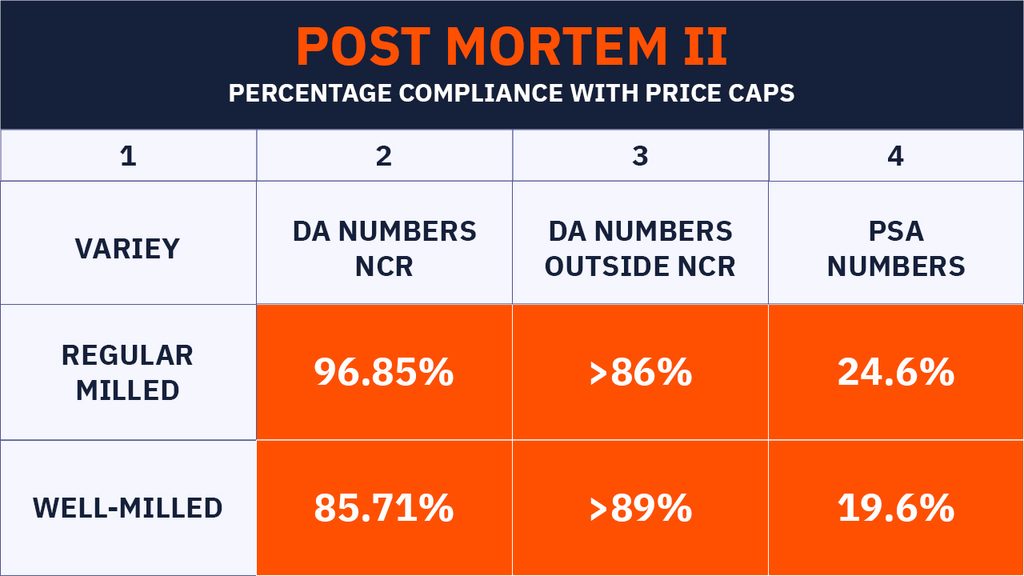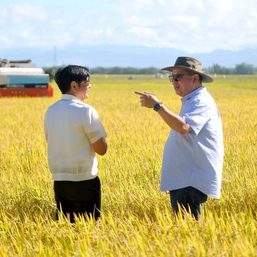SUMMARY
This is AI generated summarization, which may have errors. For context, always refer to the full article.
![[ANALYSIS] President Marcos Jr.’s ‘success story’ for rice price ceiling](https://www.rappler.com/tachyon/2023/10/post-mortem-rice-price-cap.jpg)
Editor’s note: An earlier version of this blog misstated that there are 44 million households in the Pantawid Pamilyang Pilipino Program or 4Ps thus leading to an erroneous mathematical computation. The correct figure is 4.4 million, and the computation has been corrected.
To recall, see last week’s blog, A post-mortem on the rice price ceiling: Rice price ceilings were imposed, and 30 days later, lifted by the President, both times on the joint recommendation of the Department of Trade and Industry (DTI) and DA (Department of Agriculture).
The National Economic and Development Authority (NEDA) was never consulted.
Data from the Philippine Statistics Authority (PSA) show that average rice prices in September were 15.9% and 17.1% above the price caps for regular- and well-milled rice, respectively. The compliance rate (percentage of rice varieties sold at the price caps), also per the PSA data, averaged 21.8%
From the data, one would have to conclude that imposing price ceilings on rice were a complete failure. Yet to hear it from the President himself, Executive Order (EO) 39 was a success. But what evidence do they have to support this conclusion? Let us see.
Consider this headline from the Presidential Communications Office (PCO) on Oct. 7: “Price cap stabilized rice prices – PBBM“
On October 4, 2023 when the rice price ceiling was lifted, the Philippine News Agency quotes the President as saying, “I think it’s the appropriate time since namimigay tayo ng bigas (we are distributing rice). As of today, we are lifting the price caps on the rice, for the regular-milled rice and for the well-milled rice. So, tinatanggal na natin ‘yung mga kontrol (we are removing the controls).”
Got that, Reader? Well, neither did I. An unscripted president may be as incomprehensible as a cokehead. What does the distribution of rice have to do with the “appropriate” time to lift the price caps? The 42,128 sacks of rice (25 kg each) he has been distributing is a drop in the bucket compared to the 49 million sacks of rice that the country consumes per month!
Put in another way, these 42,128 sacks as distributed by the President to Pantawid Pamilyang Pilipino Program (4Ps) beneficiaries all over the country, arranged by the Department of Social Welfare and Development, will reach 42,128 households. There are a total of 4.4 million households in the 4Ps program. That’s – let’s do the math together – 42,128 ÷ 4,4000,000 = 0.00957. This means less than one per cent of the country’s poor are benefitted.
But who cares? All the sound and hoopla are great for the President’s image of champion of the poor, if that is the real objective.
But there is another PCO headline on Oct. 6: “DA Records Stable Rice Prices since Rice Price Cap Implementation”
And the story quotes DA Undersecretary Leocadio Sebastian as saying: “DA price monitoring after lifting the price cap shows a stable rice price at the price cap levels” and that they are expecting the rice prices to decrease, particularly in rice-producing areas in the Philippines “as the new supply from the ongoing harvest comes in.”
The same story quotes DA Assistant Secretary Arnel de Mesa as saying that the Bantay Presyo Task Force is continuously monitoring the rice prices in the market. Their findings: 46 markets in the National Capital Region (NCR) showed an overall compliance rate to the mandatory price ceiling of 96.85 percent for regular-milled rice and 85.71 percent for well-milled rice. The Areas Outside NCR more than 89 percent of the well-milled rice retailers and more than 86 percent of regular-milled rice retailers selling within the mandatory price ceiling.
Compare the above compliance rates with those reported by Dennis Mapa, head of the PSA, showing a compliance rate of 24.6% for regular-milled rice and 19.6% for well-milled rice nationwide or an average of 21.8%

Why the huge disparity between the DA and the PSA findings? Who are we to believe?
I searched for answers in the DA website. It has a Bantay Presyo section, which claims to give “Daily price updates of various agricultural and basic commodities in Major Markets Nationwide”. Well, there are daily price updates, but these are not nationwide, they are only for the National Capital Region (NCR). The rice prices come from only 13, not 46 markets in Metro Manila, and the most number of markets monitored (e.g. pork) is 31. Their graphs are circa 2020. So, no illumination from there.
In any case, the PSA and its Statistical System holds high repute in the international statistical community, and is one of the best, if not the best, among the ASEAN-5. So Reader, I’ll take its data any time, over the DA. The PSA has no axes to grind.
Understand, Reader, that even the PSA’s Mapa did not want to go afoul of the President. He was hemming and hawing and soft-pedalling, and talking about counterfactuals, trying to make things look better for PBBM. Give him A for effort, in that direction. But the data, the facts, are there for all to see. I hope, for the good of the country, that the President makes more use of the PSA (and the NEDA, too) in formulating his evidence-based actions.
But it looks like an impossible task for him to do so, as seen by the following news item from the Philippine News Agency (PNA): “Despite the lifting of EO 39, Marcos said the government still needs to address the issue of the higher price of rice in Metro Manila.”
“Noong tinitignan naming kahapon ‘yung statistics, ang problema talaga ay dito sa NCR, dito mataas ang presyo ng bigas (When we were looking at the statistics yesterday, the real problem is here in the National Capital Region, where the price of rice is high).
“But that’s natural dahil nasa city tayo. Matagal bago dumating ang bigas dito at nagiging mahal and transportation, storage, processing fee. Dahil doon kaya naman tumataas and presyo dito sa NCR (But that’s natural because we’re in the city. It takes a long time for the rice to arrive here and the transportation, storage, and processing fees become expensive. The price is rising here in the NCR because of that).”
The President said he had already instructed House of Representatives Speaker Martin Romualdez to launch a program that would task the 33 congressmen from the country’s metropolis to distribute rice to affected individuals.
Read the PSA reports on prices (they come out every month), Mr. President.
The price of rice in the NCR is LOWER, not higher, than rice prices outside of NCR. It does not take a long time for rice to arrive here. So, either you misheard or misread the statistics reported, or you just want to make political points with the 33 Metro Manila congressmen, and the vote-rich NCR. And I want to remind you that the latest (2021) family poverty incidence in Metro Manila, per the PSA, is 2.2%. For the Philippines as a whole it is 13.2%. What does that tell you, for heaven’s sake (a large, frustrated sigh coming from me)? – Rappler.com
Solita “Winnie” Monsod was the first National Economic and Development Authority secretary appointed after the fall of the Marcos dictatorship in 1986. She is a professor emerita at the UP School of Economics where she taught starting 1983. She finished her degree in economics in UP and obtained her masters in economics at the University of Pennsylvania. She is a board director of Rappler Inc.
1 comment
How does this make you feel?
![[ANALYSIS] EO 39 makes no sense: Refuting the reasons for a price ceiling on rice](https://www.rappler.com/tachyon/2023/09/tl-rice-price-cap.jpg?fit=449%2C449)





![[In This Economy] Marcos’ POGO ban is popular, but will it work?](https://www.rappler.com/tachyon/2024/07/thought-leaders-marcos-pogo-ban.jpg?resize=257%2C257&crop=255px%2C0px%2C720px%2C720px)
![[Rappler Investigates] POGOs no-go as Typhoon Carina exits](https://www.rappler.com/tachyon/2024/07/newsletter-graphics-carina-pogo.jpg?resize=257%2C257&crop=424px%2C0px%2C1080px%2C1080px)





![[Just Saying] SONA 2024: Some disturbing points](https://www.rappler.com/tachyon/2024/07/TL-marcos-sona-points-july-23-2024.jpg?resize=257%2C257&crop=335px%2C0px%2C720px%2C720px)



![[ANALYSIS] How one company boosts farmer productivity inside the farm gate](https://www.rappler.com/tachyon/2024/06/bioprime-farmgate-farmer-productivity-boost.jpg?resize=257%2C257&crop=465px%2C0px%2C1080px%2C1080px)

I would like to express my gratitude to Professor Winnie Monsod for her enlightening economic article entitled “President Marcos Jr.’s ‘success story’ for rice price ceiling”. One statement particularly caught my attention, “I hope, for the good of the country, that the President relies more on PSA and NEDA in formulating his evidence-based actions.” It appears that President Marcos Jr. may be biased towards the DA data, given that he is the head of the agency. Furthermore, it seems that his actions are not based on evidence but rather on image and propaganda. This means that his image and propaganda take precedence over any available evidence.